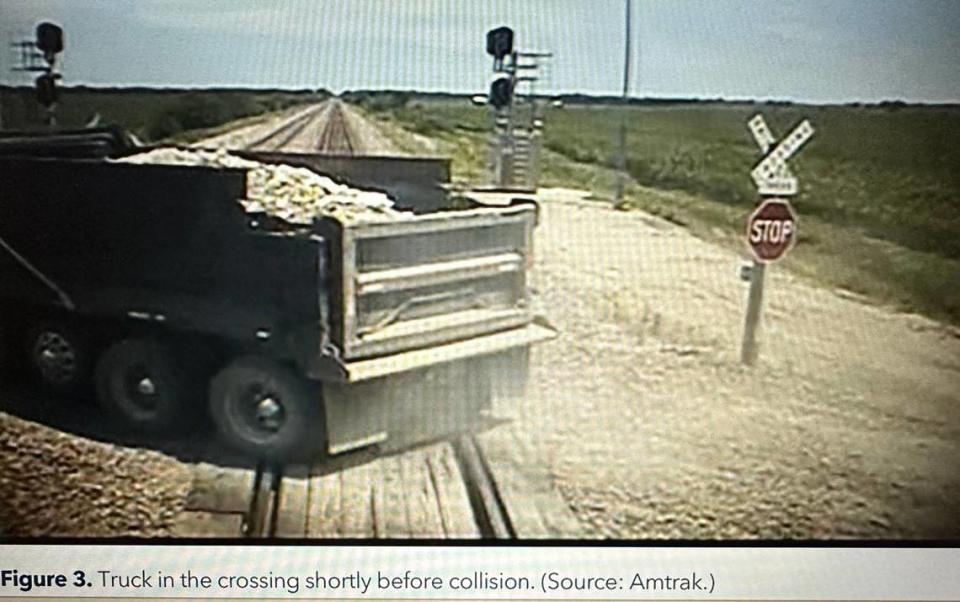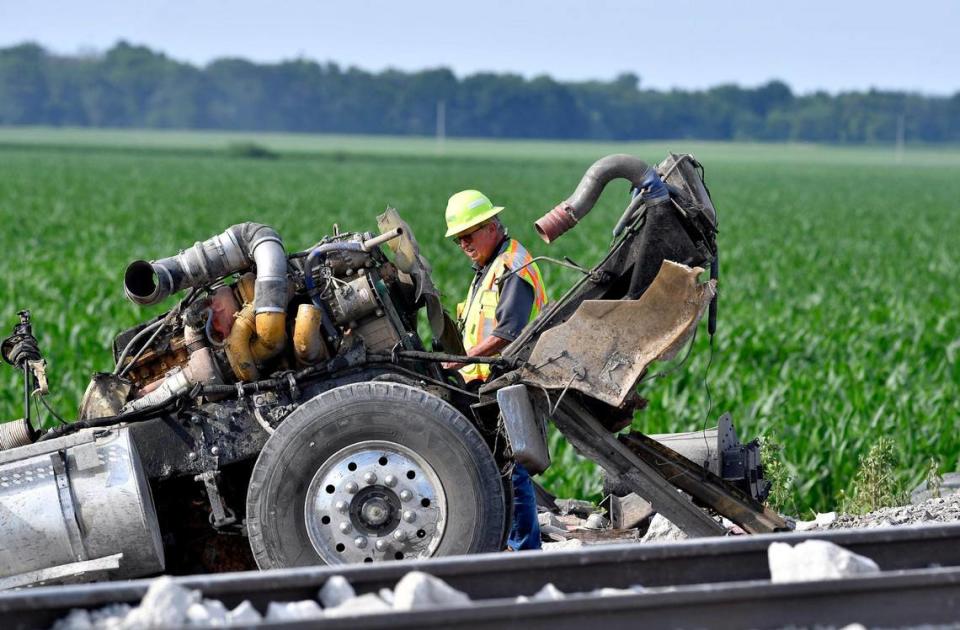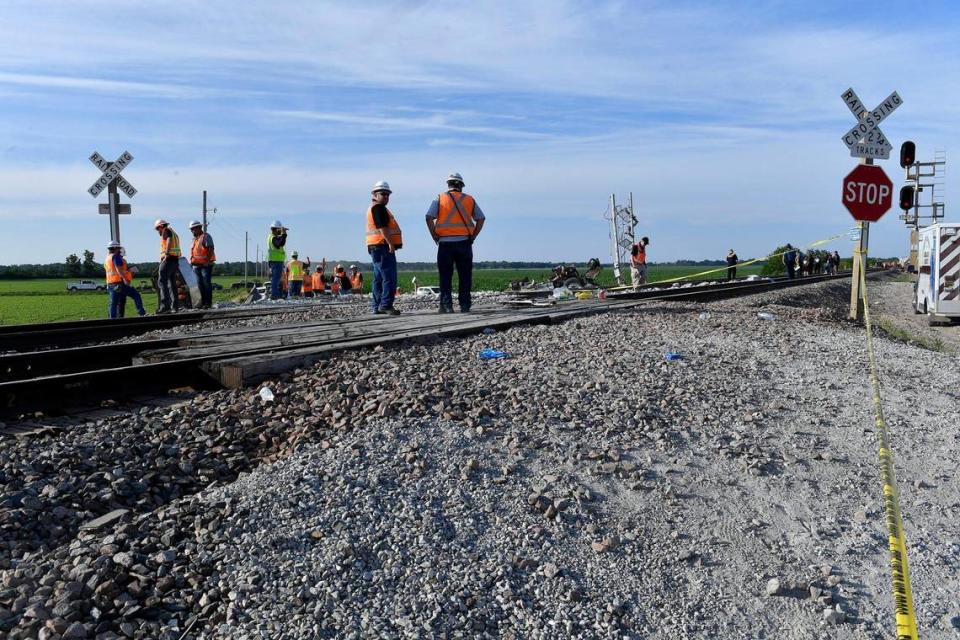Report gives cause of deadly Amtrak crash as Missouri set to fix dangerous rail crossings
A federal transportation board’s final investigative report confirms that flaws at a northern Missouri railroad crossing contributed to an Amtrak derailment that killed four and injured 146 last June.
The findings mirror what The Star revealed in the days and months after the crash, which brought attention to dangerous crossings throughout the state.
The gravel road leading up to the crossing near Mendon, Missouri, was too steep — 13 times the maximum slope recommended by the American Association of State Highway and Transportation Officials, the NTSB report said. This sharp incline was one of the contributing factors of the June 27 derailment, it said.
“The steepness of the grade made accelerating through the crossing difficult if a truck came to a complete stop as required by Missouri law,” according to the National Transportation Safety Board’s recent report. The NTSB also said the 45-degree angle of the intersection between the tracks and roadway made it more difficult for drivers to see approaching trains.
The probable cause of the derailment, the NTSB said, “was the truck driver proceeding for unknown reasons into the highway-railroad grade crossing without stopping despite the presence of a stop sign and approaching train.”

Residents of the area, who had complained about the crossing for years, said trucks couldn’t stop or they wouldn’t be able to make it over the steep incline.
The NTSB findings come as Gov. Mike Parson and the Missouri Department of Transportation are scheduled to announce details Thursday of a $50 million “historic” plan to increase safety at many of the state’s railroad crossings.
A portion of those funds will focus on upgrades at the 47 passive rail crossings on the state’s three rail lines that carry passenger rail, according to the Missouri Department of Transportation. Passive rail crossings do not have lights or gates to warn motorists of oncoming trains.
The crossing where the Amtrak derailment occurred only had crossbucks and stop signs.
After the crash, a Star investigation found that at least 12 people had died in the past 2½ years in crashes at Missouri railroad crossings that had been scheduled for improvements but were never completed — including the Mendon crossing where the Amtrak derailment occurred and another Chariton County crossing.
The seven crossings where the deadly crashes occurred had appeared on multiple improvement plans and had been identified as needing warning devices, such as lights and gates, The Star found. But the question of who is ultimately responsible for crossing upgrades or safety improvements — railroad companies, the state or local governments that maintain adjoining roads — isn’t always clear. And figuring it out can turn into a bureaucratic and legal mess.
Chariton County residents, railroad experts and local government leaders said if known hazards at crossings across Missouri weren’t corrected in a more timely manner, many more could be killed or injured.

MoDOT said installing lights and gates at a crossing costs an average $400,000, and the state had “very limited railroad safety crossing funds.”
In its new report, the NTSB report said two of the passenger fatalities occurred in the vestibule of the lounge car, the fifth railcar behind the two locomotives. The cause of death was compression asphyxia, it said.
Soil and ballast — the material that makes up the track bed, usually gravel or crushed stone — had accumulated inside the passenger compartment near two dislodged windows on the lower level, and a door had been pushed inward, allowing a one-to-four-foot pile of ballast and dirt to accumulate in the area where the passengers were found.
The report said the investigation could not identify the position or circumstances of the third passenger fatality who was evacuated to a hospital. The cause of death was blunt force trauma.
The trucker was pronounced dead at the scene, the report said.
The NTSB’s investigation found that the dump truck “proceeded into the crossing without stopping.” Missouri law, the report said, requires motorists to stop between 15 and 50 feet from highway-railroad grade crossings equipped with a stop sign. Or, it said, if a train is “within hazardous proximity — conditions that were both present as the truck neared the crossing before the collision.”
“However, the truck driver maintained a speed of about 5–6 mph through the crossing as shown by image recorder data.”

The NTSB report said another trucker, who worked for the same company and drove a dump truck similar to the one struck by the Amtrak train, told the Missouri Highway Patrol that he usually didn’t stop on the steep part of the grade because it was too difficult to get going again. He said he instead slowed or stopped on the level part of the grade.
“The collision truck driver’s movement through the crossing was therefore consistent with how the witness driver would proceed with no train present,” the NTSB said. “This suggests that the driver involved in the collision did not see the train as he approached and entered the crossing.”
The NTSB said it reviewed phone records for the train engineer’s and trucker’s personal cell phones to see if either was distracted before the collision.
“Records show that the train engineer did not make or answer calls, send text messages, or use an internet connection in the hour before the collision,” it said. “The records also show that the truck driver did not make or answer calls or send text messages in the hour before the collision; information on internet connectivity was not available.”
Chariton County officials closed the crossing after the crash, which Amtrak and the BNSF Railway Company estimated caused about $4 million damage to the track and equipment, the report said.
“The county is working with local, state, and federal partners to close other passive crossings and direct highway traffic through active crossings,” it said. “As of July 2023, the Missouri Department of Transportation plans to fund grade crossing improvements.”

